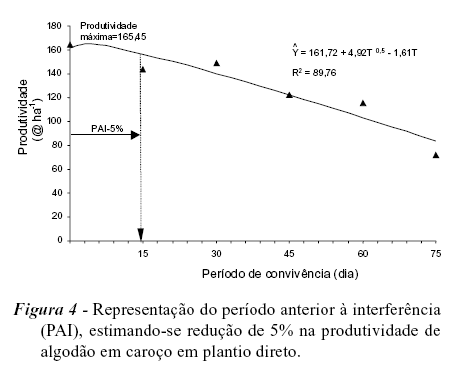An experiment was conducted in clay soil texture, in Viçosa-MG, Brazil, during the growing season 1989/1999, to evaluate the periods of weed coexistence in a cotton crop under no-tillage. The treatments were: 0, 15, 30, 45, 60 and 75 days after crop seeding under weed coexistence, and maintained weed free until crop harvest. The plots consisted of six rows 4 m long, and 0.9 m spaced, with six plants per meter. At the end of each coexistence period, the weeds were evaluated, by determining the number of species and shoot dry matter weight. The average crop plant height was also evaluated; 125 days after emergence (DAE), boll numbers per plant, and node numbers until insertion of the first fruitful branch were also evaluated, while cotton productivity was evaluated at harvesting. The average accumulation of the total dry matter of weeds was 4.7 g m-2 day-1. When comparing the treatments with and without weed interference, it was observed that weed interference throughout the cycle increased the average node numbers until insertion of the first fruitful branch, but reduced the average boll numbers and height of the plants. Weed interference throughout the cotton plant cycle caused a reduction of 81.2% in cotton productivity. Considering the 5% loss in productivity as acceptable, the period previous to weed interference was14 DAE.
weed; sorghum straw; competition; productivity; no-till








